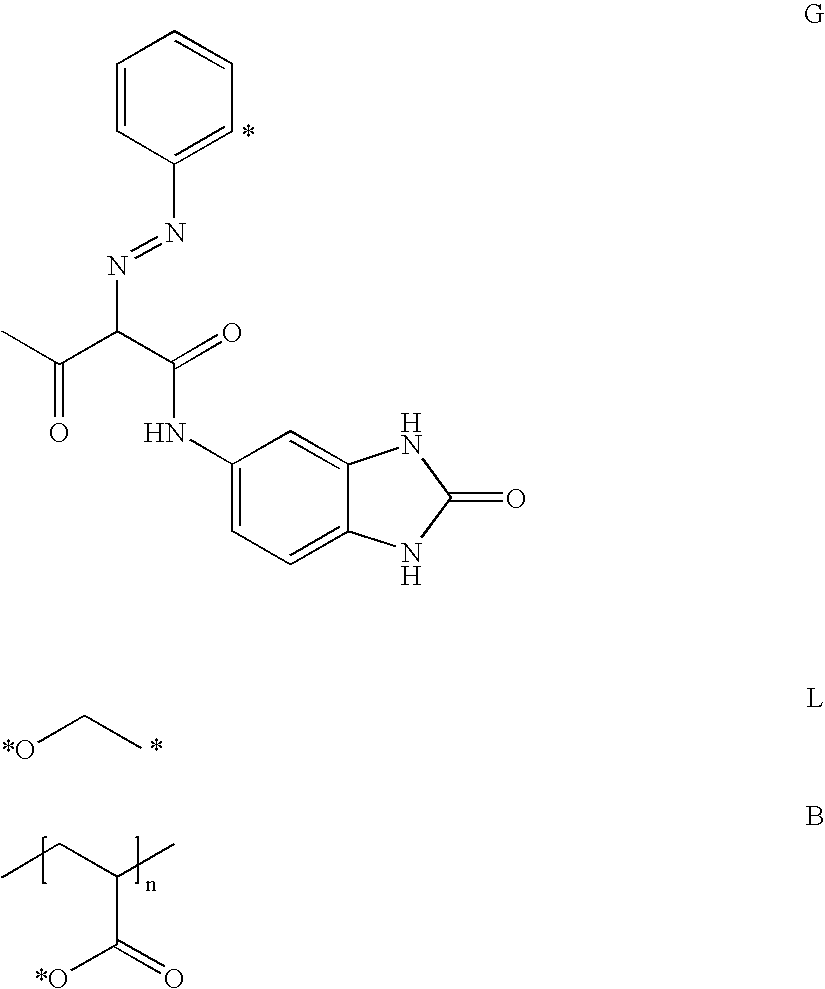Pigment Dispersions with Polymeric Dispersants Having Pending Chromophore Groups
a polymer dispersant and pigment dispersant technology, applied in the field of stable pigment dispersions and pigmented inkjet inks, can solve the problems of polymer dispersants incurring financial penalties, dispersed pigment particles may have a tendency to re-agglomerate, poor dispersion stability, etc., and achieve the effect of increasing the concentration of humectants
- Summary
- Abstract
- Description
- Claims
- Application Information
AI Technical Summary
Benefits of technology
Problems solved by technology
Method used
Image
Examples
example 1
[0167]This example illustrates that different pigments for inkjet inks can be dispersed using the same polymeric dispersant having one or more pending chromophore groups similar to the pigments. The polymeric backbone of the dispersant is a homopolymer or an alternating polymer, which are known to have poor dispersing capability.
Polymeric Dispersants DISP-1 and DISP-2
[0168]VERSICOL E5, a homopolymer of acrylic acid was used as polymeric dispersant DISP-1. The polymeric dispersant DISP-2 was prepared by modifying VERSICOL E5 through esterification with the chromophore MC-2.
Chromophore MC-2
[0169]The formation of the chromophore MC-2 was accomplished by diazotation of compound MC-1D and subsequent coupling in the compound MC-2B.
Preparation of Compound MC-1C
[0170]The vessel used to carry out this reaction was a 3 necked flask equipped with a stirrer, a cooler, and a dropping-funnel. To a solution of 13.9 g (0.1 mol) 2-nitrophenol (compound MC-1A) in 100 mL dimethylformamide was added 31...
example 2
[0204]This example illustrates the improved thermal stability of inkjet inks using a polymeric dispersant in accordance with preferred embodiments of the present invention for statistical copolymers. It is also shown that the polymeric dispersants can be obtained by uncomplicated synthesis.
Polymeric Dispersants DISP-7 and DISP-8
[0205]Styrene acrylic acid copolymers are used by several inkjet-ink manufacturers for preparing inkjet inks exhibiting good dispersion quality. It is used here in a comparative inkjet ink as polymeric dispersant DISP-7.
Synthesis of Polymeric Dispersant DISP-8
[0206]The polymeric dispersant DISP-8 was prepared by modifying Joncryl™ 678 with the chromophore MC-2 according to the synthetic scheme:
[0207]36.8 g Joncryl™ 678 was dissolved at 70° C. in 500 mL toluene and 70 mL dimethylacetamide. 5.2 g of the chromophore MC-2 and 2.7 g of p-toluene sulfonic acid monohydrate was added and water was removed azeotropically for 10 hours. The reaction mixture was allowed ...
PUM
| Property | Measurement | Unit |
|---|---|---|
| dispersity PD | aaaaa | aaaaa |
| temperatures | aaaaa | aaaaa |
| solubility | aaaaa | aaaaa |
Abstract
Description
Claims
Application Information
 Login to View More
Login to View More - R&D
- Intellectual Property
- Life Sciences
- Materials
- Tech Scout
- Unparalleled Data Quality
- Higher Quality Content
- 60% Fewer Hallucinations
Browse by: Latest US Patents, China's latest patents, Technical Efficacy Thesaurus, Application Domain, Technology Topic, Popular Technical Reports.
© 2025 PatSnap. All rights reserved.Legal|Privacy policy|Modern Slavery Act Transparency Statement|Sitemap|About US| Contact US: help@patsnap.com



